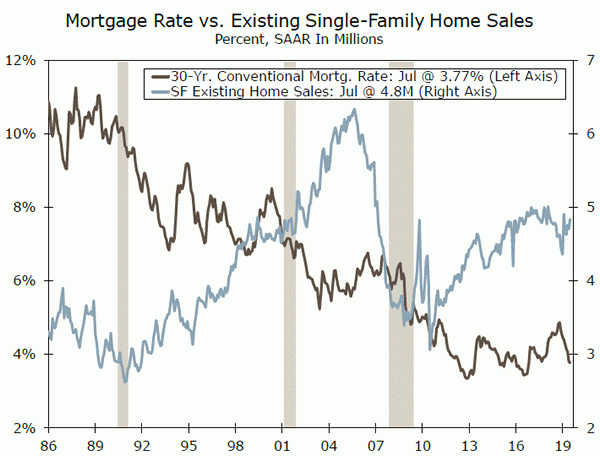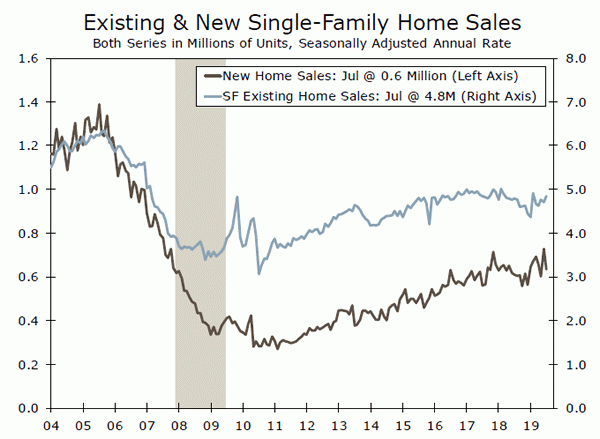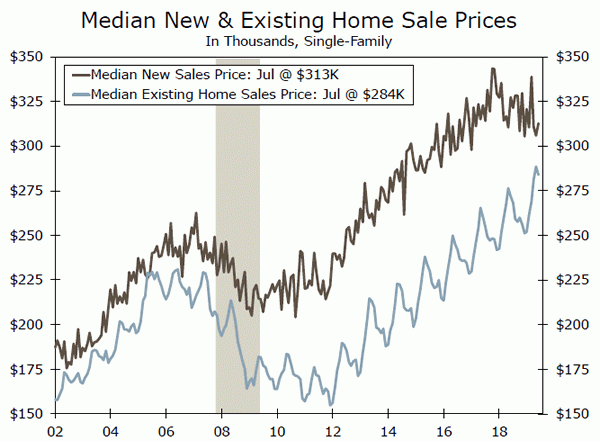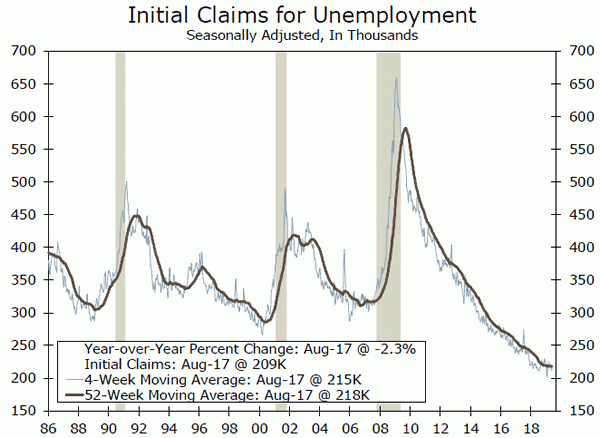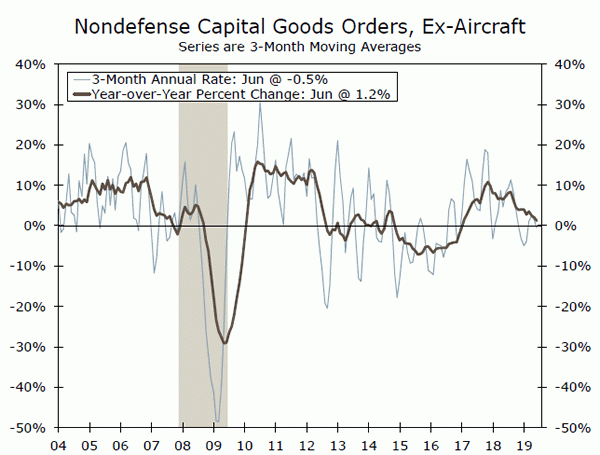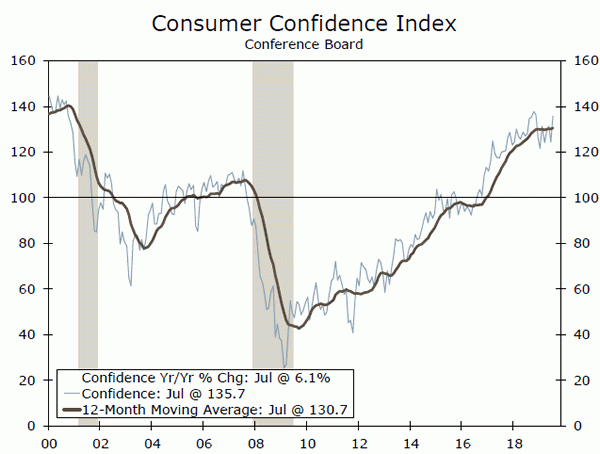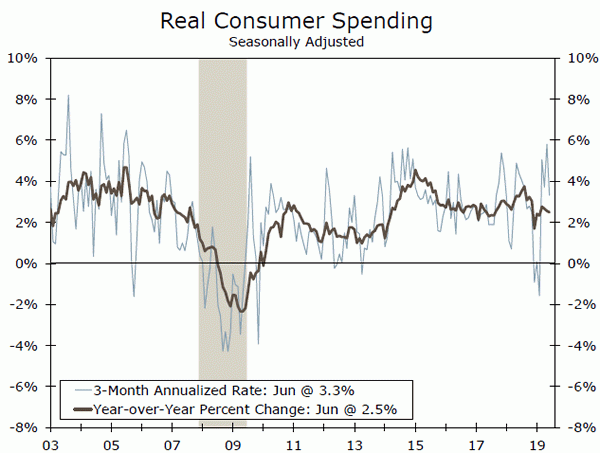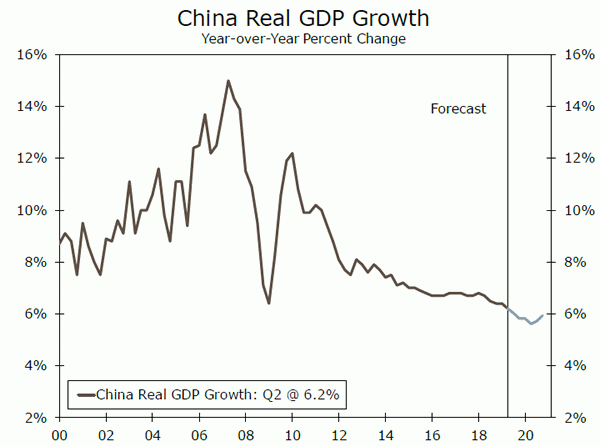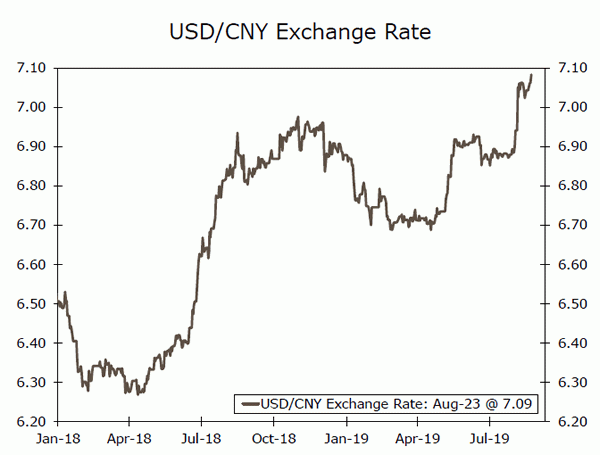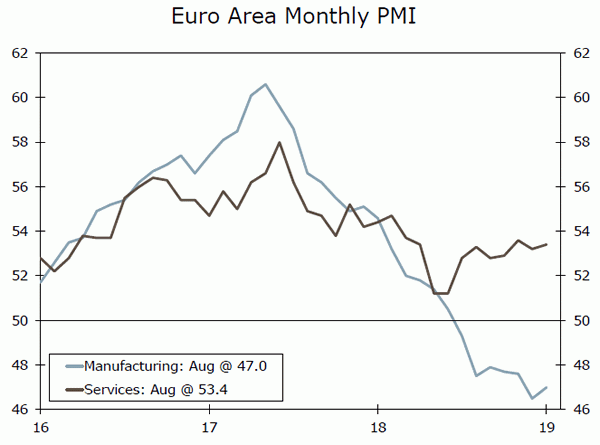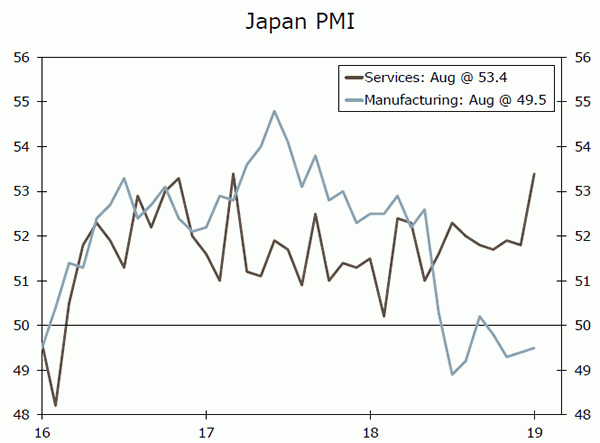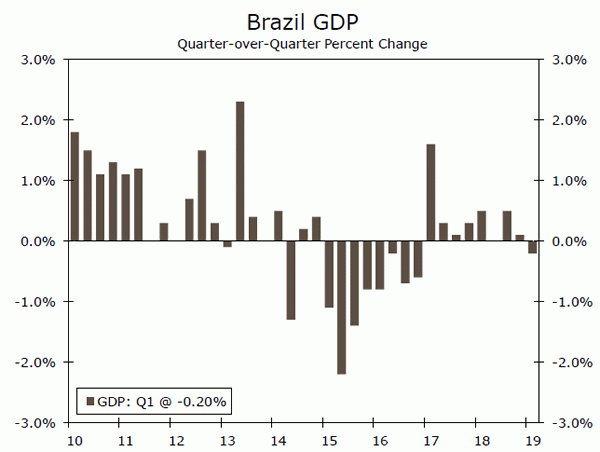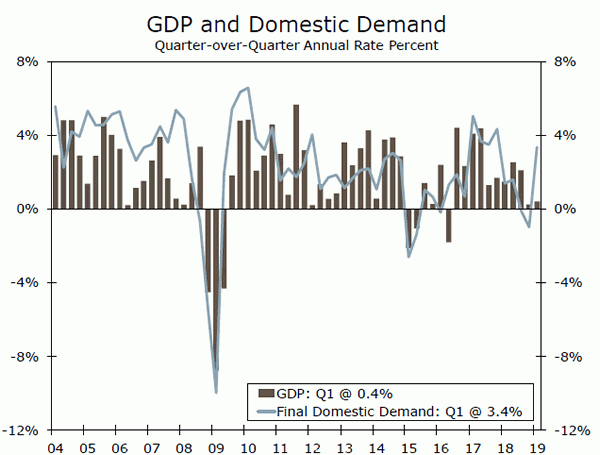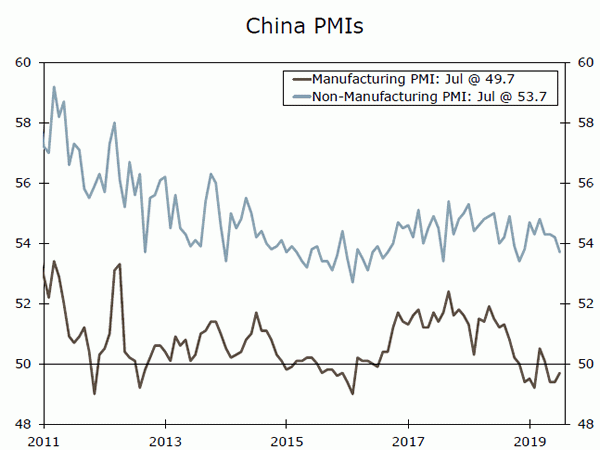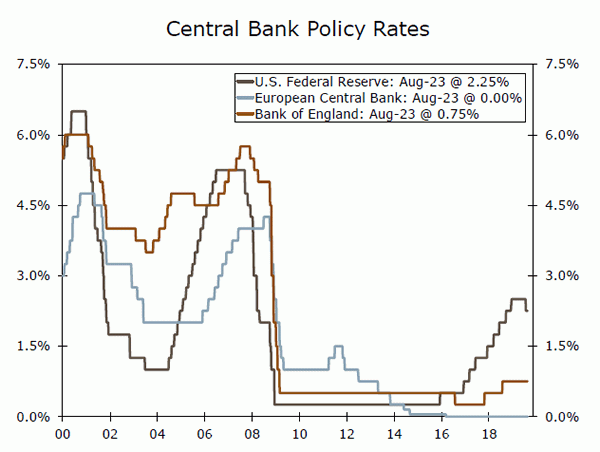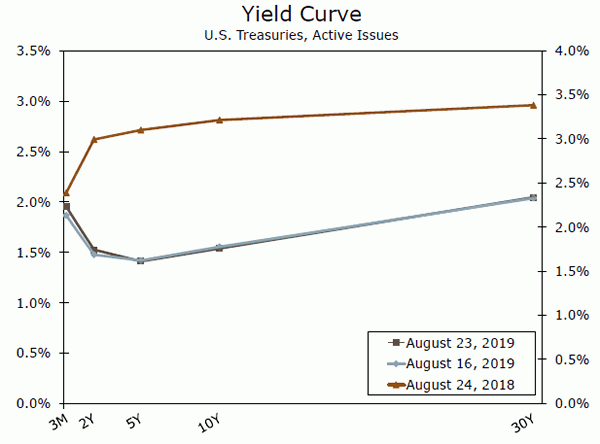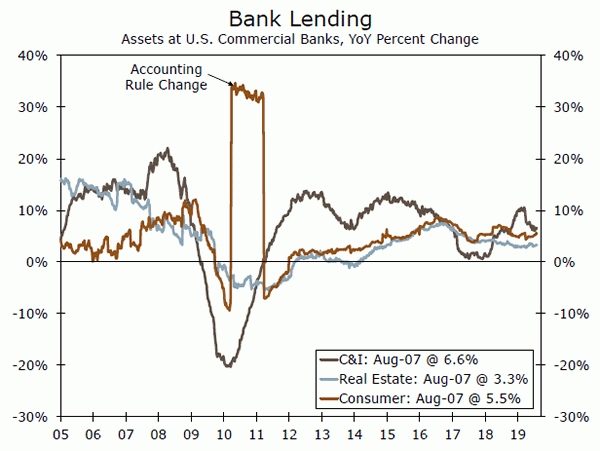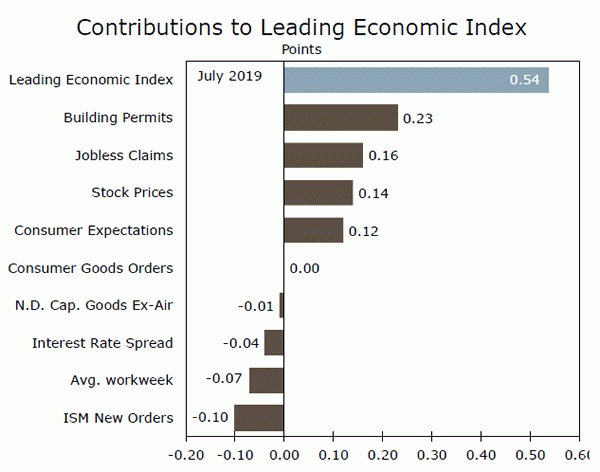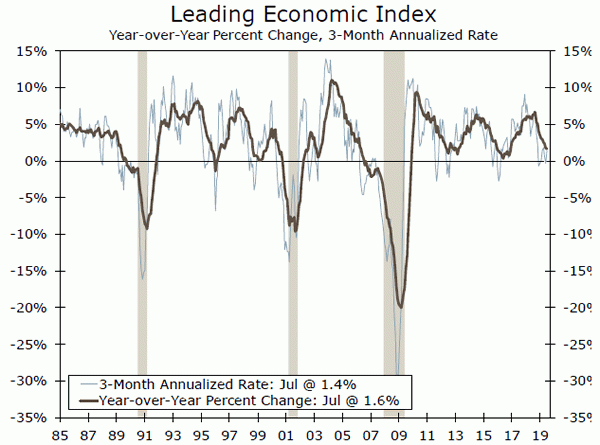U.S. Review
Powell Promises to “Act as Appropriate”
- Fed Chair Powell emphasized that the FOMC would “act as appropriate” in the face of slower global growth and an ongoing trade war, which escalated further as China announced plans to impose additional tariffs on $75 billion of U.S. goods.
- Lower mortgage rates continue to provide the housing market a modest lift. Existing home sales rose 2.5% during July. New home sales dipped 12.8%, but fell from the strongest pace of the cycle in June.
- The Leading Economic Index (LEI) increased 0.5% during July, which should calm fears of an impending downturn.
Powell Promises to “Act as Appropriate”
The yield curve once again briefly inverted this week, leaving many wondering just how vulnerable the economy is to deteriorating global growth and an ongoing trade war, which escalated further on Friday as China announced plans to impose additional tariffs on $75 billion of U.S. goods including soybeans, autos and oil. To be clear, most recent economic data indicate that the now recordlong expansion will likely continue over the near term and most of our recession-predicting models suggest a low probability of a downturn occurring in the next six months. Furthermore, a 0.5% gain in the Leading Economic Index during July should calm fears of an imminent downturn (more on this in the Topic of the Week).
There is a silver lining to lower long-term yields. Mortgage rates, which tend to follow 10-year Treasury yields closely, dipped below 4.0% during June for the first time since 2016 and are giving the housing market a modest boost. The slide in rates has led to a surge in refinancing activity and also induced a solid pickup in purchase applications. In the week ending August 16th, the MBA Mortgage Refinance Index was up 180.3% over the year, while the Purchase Index rose a solid 5.3%.
Given the recent improvement in mortgage applications, it was not surprising to see a bump in existing home sales during July. Overall resales rose 2.5% during the month to a 5.42 million-unit annual pace, while sales for June were revised slightly higher. Total home sales are now up 0.6% over the year. That marks the first positive year-over-year reading since early 2018. This is a more favorable comparison given overall weakness last year but nonetheless reflects a steadily rising trend.
Even with the recent improvement, the ongoing lack of affordable product remains an obstacle in the single-family market. During July, the National Association of Realtors once again noted that demand remains strongest for homes priced at or below the median. The general shift by buyers away from higher priced homes has helped moderate increases in home prices. Home builders have responded to this trend with more entry-level construction, a pivot which has helped keep new home sales on an upward trajectory. New home sales dipped 12.8% during July, but June sales were revised up significantly to a 728,000-unit pace, the strongest since 2007.
Fed Chair Powell capped the week with a speech at the Kansas City Fed’s Jackson Hole Symposium in which he reiterated that the FOMC will “act as appropriate” in the face of deteriorating global growth, and emphasized the need for a risk management approach to monetary policy. Earlier in the week, FOMC minutes for the late- July meeting revealed that most Fed officials viewed the recent 25 bps rate cut as a “mid-cycle adjustment”, a phrase which Powell noticeably did not use in his speech on Friday, perhaps indicating that another rate cut is coming in September. One data point more hawkish Fed officials may point to in favor of leaving rates unchanged is the consistently low level of weekly jobless claims, which is an indication of an overall healthy labor market. Initial claims for the week ending August 17th fell 12,000 to 209,000.
U.S. Outlook
Durable Goods Orders • Monday
The FOMC identified “the deceleration in economic activity in recent quarters, particularly in business fixed investment and manufacturing” [emphasis ours] as one of the three primary reasons it cut rates in July. The ubiquitous trade policy uncertainty and slowing global growth environment have sucked almost all momentum out of the manufacturing sector, particularly in regards to new capital spending and investment. Core durable goods orders have trended down since mid-2018, with most measures on any sort of moving average basis in negative territory. Manufacturing PMIs are solidly negative across many developed economies, while at 51.2 the U.S. ISM index is at its lowest level in nearly three years. We expect orders to eke out a small gain in July, but manufacturing is otherwise still on life support.
We also get a second look on Thursday at Q2 GDP, when business fixed investment declined for the first time since 2015.
Previous: 1.9% Wells Fargo: 0.7% Consensus: 1.3% (Month-over-Month)
Consumer Confidence • Tuesday
The two largest single-day equity market declines of the year likely took a sizable chunk out of consumer confidence in August. Markets plunged on news that the administration will proceed with tariffs on the balance of not yet taxed imports from China—mainly consumer good at this point—raising the specter of a surge in the cost of holidays gifts.
News shortly thereafter that these new tariffs would be delayed until December 15 may stem the extent of the decline in consumer confidence, but we still expect it to fall around six points. Financial markets rallied on the news, but the consumer may be growing weary of the constant stream of alternating “trade tensions are easing” and “trade tensions are escalating” narratives, or may not be paying attention at all. Regardless of the summer volatility, consumer confidence is still at historically high levels, with the unemployment rate holding sub-4% and wage growth gradually rising.
Previous: 135.7 Wells Fargo: 129.6 Consensus: 130.0
Personal Spending • Friday
If manufacturing PMIs and the yield curve are flashing red, the consumer has yet to tap the breaks. Personal consumption expenditures (PCE) rose at a strong 4.3% annualized rate in Q2, keeping overall GDP growth afloat amidst weakness in business and residential fixed investment. GDP revisions next week should affirm the surge was not just noise.
The strength is looking like it may continue in Q3. July retail sales beat expectations again—control group sales rose 1.0%—setting up personal spending for a solid July and Q3. Inflation as measured by the PCE deflator, the Fed’s preferred measure, remains benign. Even with an anticipated pickup in July, we expect prices to be up a mere 1.4% year-over-year. The economy may be bending a bit under the stress of a global trade war, but with the consumer so strong, it is unlikely to break.
Previous: 0.3% Wells Fargo: 0.5% Consensus: 0.5%
Global Review
Trade Tensions Escalate; PMIs Send Mixed Messages
- China announced plans to retaliate against the United States for additional tariffs. These plans include a 5% tariff on crude oil and agriculture imports from the U.S., while also re-imposing a 25% tariff on autos. In response, equity markets sold off, while the Chinese renminbi approached a new low against the U.S. dollar.
- Sentiment data released this week were rather mixed. In the Eurozone, the manufacturing and services PMI improved slightly, although we still believe the ECB will look to ease monetary policy. In Japan, manufacturing and services PMIs rose, further signaling a strengthening Japanese economy.
China’s Turn to Escalate Trade Tensions
Earlier this morning, Chinese authorities escalated trade tensions with the United States, as they announced a plan to retaliate against additional tariffs likely to be imposed by the U.S. administration. Starting September 1, the United States plans to impose a 10% tariff on a portion of the remaining imports from China, while the rest of the goods will be subject to tariffs starting in mid-December. Chinese authorities now plan to retaliate by placing a 5% tariff on imports from the United States, targeting goods such as soybeans and crude oil, which will also be imposed starting September 1. In addition, Chinese authorities indicated a 25% tariff will be re-imposed on imports of U.S. autos, which will go into effect in mid-December. Financial markets reacted sharply on the news, with global equities selling off, while the Chinese renminbi came under renewed pressure, approaching a new high of CNY7.10 against the U.S. dollar. Looking ahead, we expect the U.S. administration to move forward with its 10% tariffs and for China to impose its retaliatory tariffs as well. While we expected Chinese authorities to retaliate, these countermeasures are slightly more aggressive than we had anticipated. At this time, we expect China to grow 5.8% in 2020, with risks around this forecast likely tilted to the downside.
Eurozone Stimulus Still Likely; Japan Going Strong
For some time now, the broader European economy has been decelerating. Leading indicators of economic activity have been relatively subdued, while sentiment indicators have also softened over the course of the year. However, the most recent PMI data indicated a moderate improvement in Eurozone sentiment, with the manufacturing PMI firming to 47.0 in August, while the services PMI strengthened to 53.4. In addition, German PMI data improved, with the manufacturing PMI rising to 43.6, while the services PMI rose to 54.4. Improved sentiment in the Eurozone and Germany is encouraging, we do not believe it will be enough to prevent the European Central bank (ECB) from pursuing easier monetary policy. Given the deterioration in Eurozone economic fundamentals, we still believe the ECB will look to cut its deposit facility and main refinancing rate another 10 bps at its September meeting, while also looking to restart asset purchases in October.
In contrast to the Eurozone, we believe Japan’s economy has strengthened over the course of this year. Japan has expanded at a slow, but steady, pace for an extended period of time; however, recent sentiment data indicate a potential pick-up in the economy. Evidence can be seen in Japan’s most recent PMI data, as the services PMI rose noticeably in August, jumping to 53.4, up from 51.8 in July. While the manufacturing PMI remains in contractionary territory, it increased to 49.5 in August. A solid economy should provide less of an incentive for the Bank of Japan (BoJ) to follow other central banks and ease monetary policy. As of now, we believe the BoJ will maintain its current policy stance, and believe the economy is strong enough to absorb a planned hike in the country’s consumption tax with minimal disruptions to the broader Japanese economy.
Global Outlook
Brazil GDP • Thursday
Brazil’s economy has been under pressure since early 2015, never fully recovering from a deep recession caused by the political crisis. The political crisis has weighed on GDP growth for some time now, with the lingering effects carrying into 2019. In Q1 of this year, Brazil’s economy contracted 0.2%, while leading indicators of activity have underperformed and raised the likelihood of a technical recession in Q2. Evidence of a potential recession has been prevalent as retail sales have missed expectations throughout the second quarter, contracting 0.3% year-over-year in June. Sentiment data have also softened over the course of this year, with the manufacturing PMI falling back into contractionary territory in July. The Brazil Central Bank (BCB) cut rates more than expected in July, lowering its main Selic rate 50 bps. While consensus forecasts suggest Brazil’s economy will avoid technical recession, we expect the BCB to continue cutting policy rates into the end of the year.
Previous: -0.2% Consensus: 0.1% (Quarter-over-Quarter)
Canada GDP • Friday
The Canadian economy decelerated notably in 2018, as the dual shock of lower oil prices and planned oil production cuts weighed on the economy. However, global oil prices have rebounded in 2019, while authorities have unwound some of the oil production cuts in the Alberta region, helping the economy stabilize and start to strengthen over the course of the year. While oil production cuts are likely to stay in place for the time being, we expect oil prices to remain around current to slightly higher levels, which should help Canada’s oil sector positively contribute to quarterly GDP growth in the second quarter. Monthly GDP data have outperformed expectations recently, while other indicators of economic activity have also improved. As a result of a strengthening economy, we have recently upgraded our internal GDP forecasts for Canada, and expect the economy to grow 1.3% in 2019, and 1.8% in 2020. A stronger economy should also keep the BoC on hold for now.
Previous: 0.4% Consensus: 2.9% (Quarter-over-Quarter, Annualized)
China Manufacturing PMI • Friday
Next Friday, Chinese sentiment data will be released for the month of August, with consensus forecasts expecting the manufacturing PMI to hold steady at 49.7, still in contractionary territory. For the majority of 2019, the manufacturing PMI has been in contractionary territory as U.S.-China trade tensions have escalated over the course of the year. Given China’s plans to impose retaliatory tariffs on the United States, we expect sentiment data in China to fall further. We also believe the non-manufacturing PMI will begin to soften over time as well; however, it will likely remain in expansionary territory for the time being. As U.S.-China trade tensions continue to escalate, we believe the deceleration in China’s economy will be sharper than we previously estimated. Our most recent forecast of China GDP suggests growth could slow to 5.8% in 2020, while tariffs will likely push CPI inflation higher in China.
Previous: 49.7 Consensus: 49.7
Point of View
Interest Rate Watch
How Many bps Are in an Ounce?
At the press conference following the Fed’s decision to cut the federal funds rate a quarter percentage point in July, Fed Chair Jerome Powell noted that he viewed the move as a proactive measure to ensure that any temporary headwinds from slower global growth did not bring about a prolonged weakening in economic growth. In other words, “an ounce of prevention is worth a pound of cure.”
The adage seems appropriate for today’s circumstances, where there is plenty to worry about outside of the economic data, which look pretty healthy. The trade impasse and its depressing impact on global economic growth are front and center, as is the possibility of a hard Brexit in late October and the Fed’s desire to prolong the economic expansion so that the benefits of economic growth reach more long-suffering parts of the economy, including rural areas.
The critical question for policy makers currently gathered at the Fed’s Jackson Hole conference is how many more rate cuts should the Fed make to ward off a potential slowdown? How many more basis points are there in an ounce of caution? And if it uses them, will the Fed still be able to provide a pound of cure when it is needed? Comments from various Fed officials ahead of Powell’s speech suggest there is considerable debate about this. A number of Fed presidents sound as if the hawkish feathers have been ruffled.
Philadelphia’s Patrick Harker, Kansas City’s Esther George and Boston’s Eric Rosengren have been particularly outspoken and appear to be of the belief that no more rate cuts are needed at present. Rosengren has even stated that additional rate cuts might actually worsen the situation.
Does this mean the Fed will not cut rates in September or cut and suggest it will then be on hold? We doubt it. Monetary policy works with a long and variable lag. What the Fed does this year will impact the economy in 2020. The better data on consumer spending and resilience in the labor market are good news but should not preclude the Fed from cutting rates in September and reiterating its readiness to cut further should the slowing growth overseas present a real threat to the U.S economy.
Credit Market Insights
The Deteriorating Budget Dynamic
The federal budget deficit is now set to reach $960 billion in FY-2019 (ending Sept. 30), $63 billion more than reported in May, the Congressional Budget Office said on Wednesday. The shortfall is expected to widen to about $1 trillion in FY-2020—an unusually high number for a period of economic growth. The last time the deficit exceeded $1 trillion was in 2012, when the government was providing stimulus for a recovering economy. As a share of GDP, federal debt held by the public is expected to rise to 95% by 2029, which would mark the highest level since just after World War II.
Expansions have traditionally been associated with balanced budgets, as rising employment and wages should increase revenue while spending on programs like unemployment insurance should decline. But, in recent years, the deficit as a share of the economy has been rising, despite stronger economic growth. That is, in large part, due to the 2017 Tax Cuts & Jobs Act, which decreased revenue, but also due to increased defense spending and costs associated with an aging population. While government borrowing costs remain historically low, high debt burdens during a downturn could constrain policymakers. Countries with higher debt-to-GDP ratios during a crisis have often faced weaker recoveries, as governments have less ammunition to stimulate the economy. That could to prove troublesome in the next downturn, as the United States is currently running one of the largest budget deficits in the developed world.
Topic of the Week
I Cannot Tell a LEI
It was the best of times. It was the worst of times. Last week the bottom fell out under U.S. equity markets amid handwringing about the inverted yield curve and what it might be saying about a looming recession. Then this week, the stock market looked to have broadly recouped those losses, but a further escalation in the U.S.-China trade war on Friday erased the weekly gains. Despite recent market volatility, the Leading Economic Index (LEI) handily exceeded expectations with a 0.5% monthly gain in July. Not only was this the largest monthly increase for 2019, it places the index back at an all-time high.
Before rushing from one side of the boat to the other, it bears noting that some of the components that propelled the LEI in July could very well become headwinds in the next monthly report. Stock prices, for example, are still broadly lower than where they were in July. Also, if the preliminary read on consumer sentiment from the University of Michigan last week was any indication, consumer confidence could be headed lower as well. The biggest boost in July came from building permits, but the inherent volatility in residential construction activity makes back-to-back monthly gains rare for this component.
When we zoom out from these month-to-month swings perhaps the more compelling observation is the clear trend decline in the growth rate of the index. A breakout of the three-month annualized rate below the zero line is not a terribly disconcerting development, as that has already occurred a few times during this expansion without any major fallout for economic growth. More troubling would be if we were to see the year-over-year measure go negative. That occurred briefly without incident during the mid-cycle slowdown in the mid-90s. Other than that, every other time over the past 40 years the year-over-year growth rate went into negative territory a recession followed. With this measure at 1.6% in July, we are not at risk of that yet, but a surge in the level of the LEI in Q4-2018 means more difficult comps for the annual growth rate starting in September.




